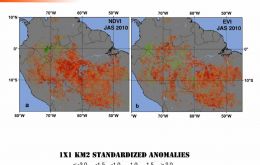MercoPress. South Atlantic News Agency
Stories for April 1st 2011
-
Friday, April 1st 2011 - 17:53 UTC
Uruguay’s fiscal deficit up in February equivalent to 1.4% of GDP

Uruguay’s fiscal deficit in February increased GDP 0.3 percentage points over the previous month and reached 1.4% of GDP according to the Economy Ministry. In nominal terms the overall public sector deficit (including regional governments and the National Insurance bank) was 453 million US dollars, 20% higher than in January.
-
Friday, April 1st 2011 - 17:51 UTC
Uruguay’s government debt up 5.9% in 2010 but down to 57.9% of GDP

Uruguay’s government debt increased both in gross and net terms in 2010, although at a slower rate than in 2009. Overall the debt increased 5.9% (1.3 billion US dollars) totalling 23.185 billion USD which is equivalent to 57.6% of GDP, according to the latest release from the central bank.
-
Friday, April 1st 2011 - 16:33 UTC
Chilean politicians’ expertise helps democratic transition in Egypt

As upheaval continues across the Middle East, the path towards democracy is far from clear. A civil war is raging in Libya as protests become deadly in Syria. The leader
of Yemen is negotiating his removal from power, and Saudi Arabian forces have been called in to help “maintain order” on the streets of Bahrain. -
Friday, April 1st 2011 - 06:47 UTC
Number of Chileans travelling abroad by air in summer doubled in ten years

The number of Chileans choosing to travel abroad by air in the summer months has increased by 17% from last year, and is double the number who travelled in 2001.
-
Friday, April 1st 2011 - 06:44 UTC
India’s population hits 1.21 billion in 2011; female foeticide remains high

India's population has grown by 181 million people over the past decade to 1.21bn, according to the 2011 census. More people now live in India than in the United States, Indonesia, Brazil, Pakistan and Bangladesh combined.
-
Friday, April 1st 2011 - 01:54 UTC
Mujica: we need Venezuela in Mercosur “to help balance the group”

Uruguayan president Jose Mujica promised his peer Hugo Chavez he would press strongly for Venezuela’s incorporation as full member of Mercosur because this will help balance the group.
-
Friday, April 1st 2011 - 01:42 UTC
Amazon drought consequences still affect an area 3.5 times the size of Texas

A new study has revealed widespread reductions in the greenness of Amazon forests caused by the last year's record-breaking drought.
-
Friday, April 1st 2011 - 01:37 UTC
In spite of Mercosur “unfulfilled agenda”, there will be trade agreement with EU

Uruguay’s Vice-president Danilo Astori said that Mercosur “unfulfilled agenda” will not affect the chances of reaching an agreement with the European Union which if finally achieved will also help the “block to work better”.
-
Friday, April 1st 2011 - 01:31 UTC
Uruguay’s two main challenges: infrastructure and education

Two are the main challenges faced by Uruguay to ensure sustained economic growth and to improve inequalities: infrastructure and education, and one main danger, self complacency.
-
Friday, April 1st 2011 - 01:22 UTC
Argentina’s high expectations for the squid season are rapidly fading

Encouraging expectations for the Illex argentinus squid season appear to be fading in Argentina. Following a start with good catches and high expectations, the average daily output of squid is now only around five tons in the area between parallels 44º and 46º South Atlantic.
